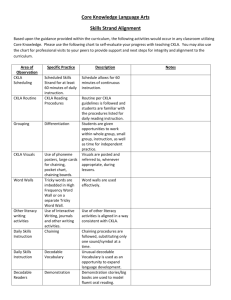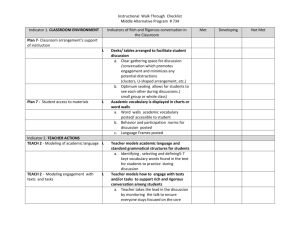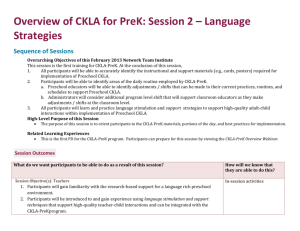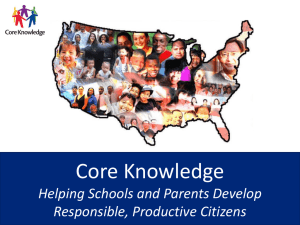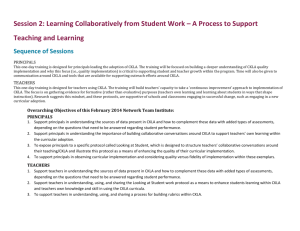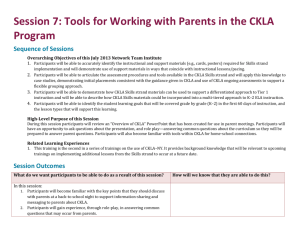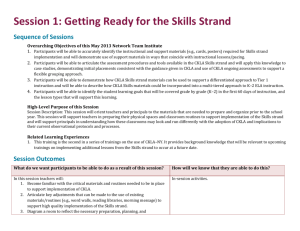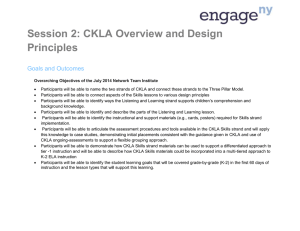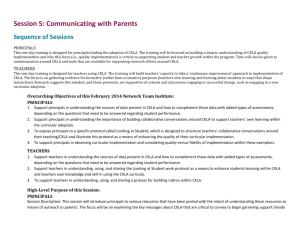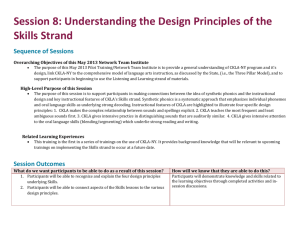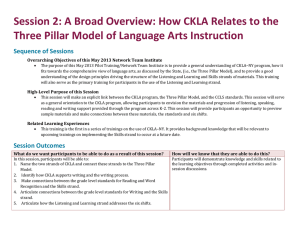Session 3, The First 60 Days of Instruction – Role Play
advertisement
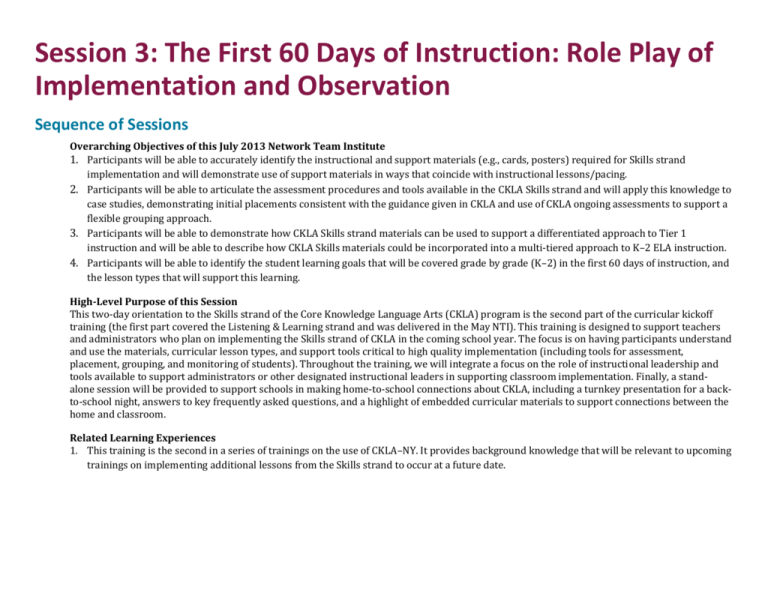
Session 3: The First 60 Days of Instruction: Role Play of Implementation and Observation Sequence of Sessions Overarching Objectives of this July 2013 Network Team Institute 1. Participants will be able to accurately identify the instructional and support materials (e.g., cards, posters) required for Skills strand implementation and will demonstrate use of support materials in ways that coincide with instructional lessons/pacing. 2. Participants will be able to articulate the assessment procedures and tools available in the CKLA Skills strand and will apply this knowledge to case studies, demonstrating initial placements consistent with the guidance given in CKLA and use of CKLA ongoing assessments to support a flexible grouping approach. 3. Participants will be able to demonstrate how CKLA Skills strand materials can be used to support a differentiated approach to Tier 1 instruction and will be able to describe how CKLA Skills materials could be incorporated into a multi-tiered approach to K–2 ELA instruction. 4. Participants will be able to identify the student learning goals that will be covered grade by grade (K–2) in the first 60 days of instruction, and the lesson types that will support this learning. High-Level Purpose of this Session This two-day orientation to the Skills strand of the Core Knowledge Language Arts (CKLA) program is the second part of the curricular kickoff training (the first part covered the Listening & Learning strand and was delivered in the May NTI). This training is designed to support teachers and administrators who plan on implementing the Skills strand of CKLA in the coming school year. The focus is on having participants understand and use the materials, curricular lesson types, and support tools critical to high quality implementation (including tools for assessment, placement, grouping, and monitoring of students). Throughout the training, we will integrate a focus on the role of instructional leadership and tools available to support administrators or other designated instructional leaders in supporting classroom implementation. Finally, a standalone session will be provided to support schools in making home-to-school connections about CKLA, including a turnkey presentation for a backto-school night, answers to key frequently asked questions, and a highlight of embedded curricular materials to support connections between the home and classroom. Related Learning Experiences 1. This training is the second in a series of trainings on the use of CKLA–NY. It provides background knowledge that will be relevant to upcoming trainings on implementing additional lessons from the Skills strand to occur at a future date. Session Outcomes What do we want participants to be able to do as a result of this session? How will we know that they are able to do this? Session Objective(s): (Teachers and Principals) 1. Participants will gain experience implementing key instructional strategies related to a grade-specific lesson type. 2. Participants will gain knowledge of behaviors and instructional techniques central to high quality implementation of a CKLA Skills lesson. 3. Participants will gain skill in making objective, behavioral observations related to implementation and using this information to provide feedback and support to implementation. Session Overview Section Time Overview Prepared Resources Role Play 90 Participants will role play lesson implementation and giving and receiving feedback with 3-step conversation protocol. 1. NTI_July2013_Session3_RolePlayandObservation.ppt 2. NTI_July2013_Session3_RolePlayandObservation_Materials.zip Handouts: 1. Checklists from previous session (e.g., Checklist_TrickyWordLesson.pdf, ChecklistBasicCodeLesson.pdf, etc.) Session Roadmap Section 1: Role Play Time: 90 minutes [30 minutes] In this section, you will… 1. Gain knowledge and experience using the 3-step protocol to give and receive feedback on lesson implementation. Materials used include: 1. NTI_July2013_Session3_RolePlayandObservation.ppt 2. NTI_July2013_Session3_RolePlayandObservation_Materials.zip Handouts: 1. Checklists from previous session (e.g., Checklist_TrickyWordLesson.pdf, ChecklistBasicCodeLesson.pdf, etc.) Facilitator Preparation Time 10 Slide #/ Pic of Slide Script/ Activity directions: (Please Note: Here we provide key ideas per slide. A full script is provided within the power point slides in the “Notes” view). Slide 3 Key Point: GROUP S 1. Prepare participants for this activity by dividing into grade level teams of 3 teachers (but by moving tables to work with someone new), plus 1 administrator (does not have to be ‘their’ administrator). 10 Slide 4 Key Points: S 1. Have groups select one of the lessons/lesson types that they have already worked with. Encourage teams to select the ‘grade specific’ lesson type we discussed and that they just practiced. As a group they will decide on a lesson type. 2. Use the handouts of lessons from Session (e.g., Checklist_TrickyWordLesson.pdf, ChecklistBasicCodeLesson.pdf, etc.). 5 Slide 5 Key Points: 1. Introduce the three part conversation protocol: a) Administrator: Identify 1–2 behavioral/objective elements of the lesson implementation that demonstrate high-quality fidelity implementation as defined by the checklist. b) Administrator: Pose a question to the “teacher” about an area of the lesson implementation that was missing or confusing. c) Teacher: State and idea for refining, adding to, or building upon the lesson implementation. 2. Model this conversation in relation to a demonstration lesson before having participants use the protocol. 3. Handouts used: Checklists from previous session – for example Checklist_TrickyWordLesson.pdf, ChecklistBasicCodeLesson.pdf, etc. S 10 Slide 6 Key Points: S 1. ROLE PLAY: Round 1 2. Have on teacher present the “Introduction” to the lesson while other participants watch using their checklist. 3. Have participants conduct the conversation protocol. 4. It will be helpful to display the next slide (the protocol) during the conversation. Slide 7 5 Key Points: 1. Display to guide the conversation. 2. Remind them that this activity is to help them dig into the lesson and practice the ‘process’ of engaging in conversations around practice. You may not have all the material and, of course, you aren’t going to be able to do everything just right. That is not the goal. Rather the goal is to provide practice with the process of identifying and having conversations about critical elements of instruction. 3. It is helpful in this first round to guide them. 4. Step 1: Take a few minutes to plan for the lesson. Groups should be three or four people. Decide who will be the first to demonstrate and what part of the lesson. 5. Step 2: Have everyone take time to examine that part of the lesson. Those observing will use the checklist to help them consider what “expectations” they may have/be looking for around the critical behaviors. The person presenting will get familiar with the lesson in specifics and gather needed materials (or have a plan for ‘working around’ the lack of materials) 6. Step 3: Tell them to go through the first demonstration and observation. Stop them after about 5 minutes. 7. Step 4: Ask them to now go into the three part conversational protocol. 8. Step 5: Ask them to write down some questions, comments, or any “ahhas,” regarding the conversation process or their lesson practice. S 10 Slide 8 Key Points: S 1. ROLE PLAY: Round 2 2. Follow the process laid out previously to guide them through the next round. Be sure a new person presents and this time someone else can ‘play’ the administrator. 3. Have on teacher present the “Practice / Support” part of the lesson while other participants watch using their checklist. 4. Have participants conduct the conversation protocol. 5. It will be helpful to display the next slide (the protocol) during the conversation. 5 Slide 9 Key Point: S Key Points: S 1. Display to guide the conversation. 10 Slide 10 1. ROLE PLAY: Round 3 2. Follow the process laid out previously to guide them through the next round. Be sure a new person presents and this time someone else can ‘play’ the administrator. 3. Have on teacher present the “Practice / Support” part of the lesson while other participants watch using their checklist. 4. Have participants conduct the conversation protocol. 5. It will be helpful to display the next slide (the protocol) during the conversation. 5 Slide 11 Key Point: S 1. Display to guide the conversation. Slide 12 10 Key Points: S 1. Debrief. 2. Consider questions and concerns for how this might play out at your school (with your administrator or teachers). 3. Take away: We do encourage ‘open practice’ and constructive (not evaluative) conversations around practice when beginning CKLA. It is a complex program and with the right context of support, these sorts of conversations are important. Perhaps this type of observation and discussion can occur among teams of teachers. 4. What are your ideas? Use the following icons in the script to indicate different learning modes. Video Reflect on a prompt Active learning Turnkey Materials Provided See handouts for lesson type checklists (blank for use during activity; completed to be reflected on after the activity) Additional Suggested Resources Turn and talk
